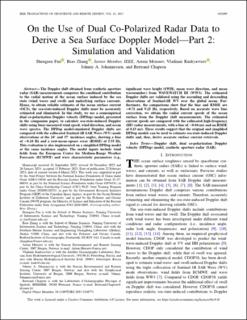| dc.contributor.author | Fan, Shengren | |
| dc.contributor.author | Zhang, Biao | |
| dc.contributor.author | Moiseev, Artem | |
| dc.contributor.author | Kudryavtsev, Vladimir | |
| dc.contributor.author | Johannessen, Johnny Andre | |
| dc.contributor.author | Chapron, Bertrand | |
| dc.date.accessioned | 2023-10-20T11:25:54Z | |
| dc.date.available | 2023-10-20T11:25:54Z | |
| dc.date.created | 2023-05-08T10:58:32Z | |
| dc.date.issued | 2023 | |
| dc.identifier.issn | 0196-2892 | |
| dc.identifier.uri | https://hdl.handle.net/11250/3097781 | |
| dc.description.abstract | The Doppler shift obtained from synthetic aperture radar (SAR) measurements comprises the combined contribution to the radial motion of the ocean surface induced by the sea state (wind waves and swell) and underlying surface currents. Hence, to obtain reliable estimates of the ocean surface current (OCS), the sea-state-induced Doppler shifts must be accurately estimated and eliminated. In this study, we use a semiempirical dual co-polarization Doppler velocity (DPDop) model, presented in the companion paper, to calculate sea-state-induced Doppler shifts using buoy-measured wind speed, wind direction, and ocean wave spectra. The DPDop model-simulated Doppler shifts are compared with the collocated Sentinel-1B SAR Wave (WV) mode observations at the 24° and 37° incidence angles, showing a bias of −0.24 Hz and a root-mean-square error (RMSE) of 5.55 Hz. This evaluation is also implemented on a simplified DPDop model at the same incidence angles. The model inputs include wind fields from the European Center for Medium-Range Weather Forecasts (ECMWF) and wave characteristic parameters (e.g., significant wave height (SWH), mean wave direction, and mean wavenumber) from WAVEWATCH III (WW3). The estimated Doppler shifts are validated using the ascending and descending observations of Sentinel-1B WV over the global ocean. Furthermore, the comparisons show that the bias and RMSE are −0.71 and 9.25 Hz, respectively. Based on accurate wave bias correction, we obtain the radial current speeds of the ocean surface from the Doppler shift measurements. The estimated current speeds are compared with the collocated high-frequency (HF) radar measurements, with a bias of −0.04 m/s and an RMSE of 0.15 m/s. These results suggest that the original and simplified DPDop models can be used to estimate sea-state-induced Doppler shifts and, thus, derive accurate surface current retrievals. | en_US |
| dc.language.iso | eng | en_US |
| dc.publisher | IEEE | en_US |
| dc.rights | Navngivelse 4.0 Internasjonal | * |
| dc.rights.uri | http://creativecommons.org/licenses/by/4.0/deed.no | * |
| dc.title | On the Use of Dual Co-Polarized Radar Data to Derive a Sea Surface Doppler Model - Part 2: Simulation and Validation | en_US |
| dc.type | Journal article | en_US |
| dc.type | Peer reviewed | en_US |
| dc.description.version | publishedVersion | en_US |
| dc.rights.holder | Copyright 2023 the authors | en_US |
| dc.source.articlenumber | 4202009 | en_US |
| cristin.ispublished | true | |
| cristin.fulltext | original | |
| cristin.qualitycode | 2 | |
| dc.identifier.doi | 10.1109/TGRS.2023.3246771 | |
| dc.identifier.cristin | 2146093 | |
| dc.source.journal | IEEE Transactions on Geoscience and Remote Sensing | en_US |
| dc.identifier.citation | IEEE Transactions on Geoscience and Remote Sensing. 2023, 61, 4202009. | en_US |
| dc.source.volume | 61 | en_US |

